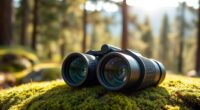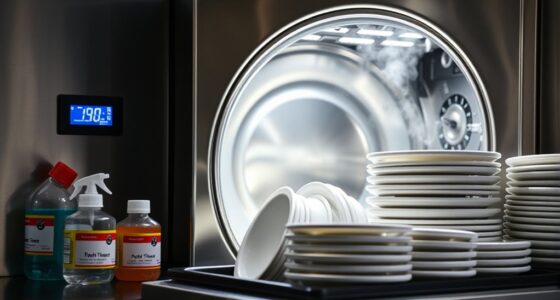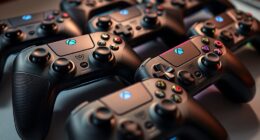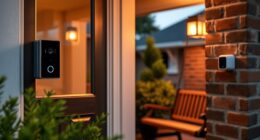To calibrate your thermometer, use certified reference standards like ice baths and boiling water to establish baseline points. Immerse your thermometer and compare its readings with these standards at various temperatures. Record all measurements carefully for future reference or compliance checks. Adjust the device as needed following the manufacturer’s instructions, then verify accuracy to guarantee reliable results. Continuing this process regularly helps maintain precision and confidence in your measurements.
Key Takeaways
- Use certified reference standards like ice baths (0°C) and boiling water (100°C) to benchmark thermometer accuracy.
- Record calibration measurements meticulously, noting deviations and adjustments for traceability.
- Follow manufacturer instructions for precise calibration adjustments, such as zeroing or offset corrections.
- Verify accuracy after adjustments and document results to ensure compliance and ongoing reliability.
- Schedule regular calibration intervals considering environmental factors, usage, and device aging to maintain measurement precision.
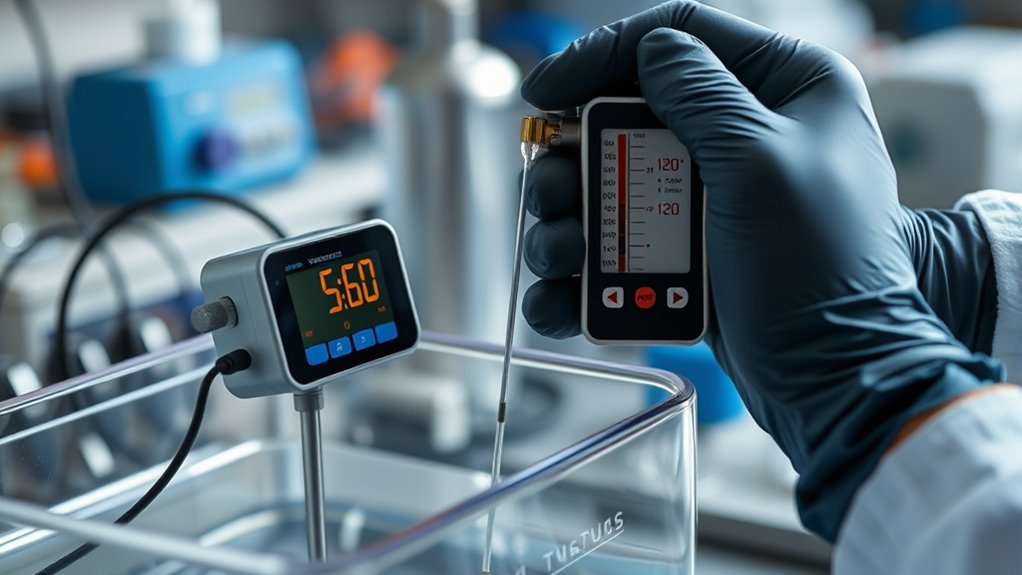
Accurate temperature measurement is essential in many industries, and proper thermometer calibration guarantees you get reliable readings. Calibration standards are the foundation for ensuring measurement accuracy, providing a consistent benchmark against which your thermometers are checked and adjusted. When you calibrate correctly, you’re aligning your instrument’s readings with recognized reference points, which helps maintain precision over time. This process is crucial in sectors like pharmaceuticals, food safety, manufacturing, and healthcare, where even minor discrepancies can lead to significant issues. By adhering to established calibration standards, you ensure that your thermometer’s measurements are trustworthy, reducing errors and improving overall quality control.
Maintaining accurate temperature readings through proper calibration is vital across industries.
To start calibration, you need to select appropriate reference standards. These standards are typically certified temperature sources, such as ice baths for 0°C or boiling water for 100°C, which serve as your baseline points. Using these standards, you compare your thermometer’s readings at various points across its range. If your device shows deviations from these standards, you’ll need to adjust it accordingly to restore measurement accuracy. This step is vital because it guarantees that your thermometer is consistent and aligned with internationally recognized calibration standards, which in turn guarantees the reliability of your temperature data.
During calibration, you should record all measurements meticulously. Documenting your readings helps track the performance of your thermometer over time and provides evidence for compliance audits. Consistent documentation also allows you to identify patterns or recurring issues, such as drift in measurement accuracy. When adjustments are necessary, follow the manufacturer’s instructions carefully, making precise adjustments to bring your thermometer within the specified calibration standards. This process might involve zeroing, offset adjustments, or other calibration techniques depending on the device type. Always verify the calibration after adjustments to confirm measurement accuracy has been restored.
Furthermore, understanding the importance of sound design techniques can enhance the overall quality of your calibration environment, ensuring minimal noise interference during precise measurements. Regular calibration is essential to maintain the precision of your thermometers. Over time, environmental factors, usage, and aging can cause measurements to drift from their original accuracy. By establishing a routine calibration schedule based on manufacturer recommendations and industry standards, you keep your instruments dependable. Remember, calibration isn’t a one-time task; it’s an ongoing process that upholds measurement accuracy, minimizes errors, and ensures compliance with quality standards. When you prioritize proper calibration procedures, you’re taking a proactive step toward maintaining high standards in your operations, minimizing risks, and ensuring that your temperature measurements are always reliable and aligned with recognized calibration standards.
Frequently Asked Questions
How Often Should Thermometers Be Recalibrated?
You should recalibrate your thermometers regularly, typically every 6 to 12 months, depending on their usage and how much temperature drift occurs. If you notice inconsistent readings or the thermometer has been dropped or mishandled, recalibrate immediately. Regular calibration ensures accuracy, helps detect temperature drift early, and maintains reliable measurements. Adjust your calibration frequency based on manufacturer recommendations and your specific operational requirements to keep your thermometers precise.
What Types of Thermometers Require Calibration?
Like a compass guiding you through unknown waters, you need to calibrate all thermometers to guarantee accuracy. Digital sensors, especially those used for critical measurements, require regular calibration to stay reliable. Analog devices, such as mercury or alcohol thermometers, also need calibration, but less frequently. Both types can drift over time, so you should check calibration periodically to maintain precise temperature readings.
Can Calibration Be Done Without Specialized Equipment?
You can attempt DIY calibration without specialized equipment, but it’s often not accurate and falls into calibration myths. While some basic thermometers might be fine with simple checks, professional calibration ensures precision. Without proper tools, your calibration might be off, risking incorrect readings. Always remember, for critical measurements, professional calibration is recommended. Relying solely on DIY methods can lead to errors, so weigh the risks before skipping proper calibration procedures.
What Are Signs of a Thermometer Needing Calibration?
If you notice your thermometer’s readings are inconsistent or drifting over time, it’s a sign it needs calibration. Look out for temperature drift, where the displayed temperature changes without actual environmental changes, or sensor malfunction, such as unresponsive or stuck readings. These issues indicate the sensor may be compromised, and calibration helps guarantee accurate measurements, preventing errors in critical applications. Regular checks maintain your thermometer’s reliability.
How Does Calibration Improve Measurement Accuracy?
When you calibrate a thermometer, you’re tightening its accuracy, ensuring temperature stability. Imagine a delicate balance, where even tiny deviations can throw measurements off. By aligning with calibration standards, you eliminate uncertainties, making your readings more reliable. This process enhances precision, giving you confidence that every temperature you record reflects reality. In short, calibration sharpens your instrument’s performance, preventing errors and ensuring consistent, trustworthy measurements every time.
Conclusion
By following these calibration procedures, you turn your thermometer into a trusted compass, guiding you accurately through temperature measurements. Think of it as fine-tuning a musical instrument—when properly calibrated, every note hits perfectly. Don’t let small errors snowball into bigger problems; instead, keep your readings sharp and reliable. With a little care, you’ll guarantee your thermometer always sings in tune, making every measurement a melody of precision and confidence.

